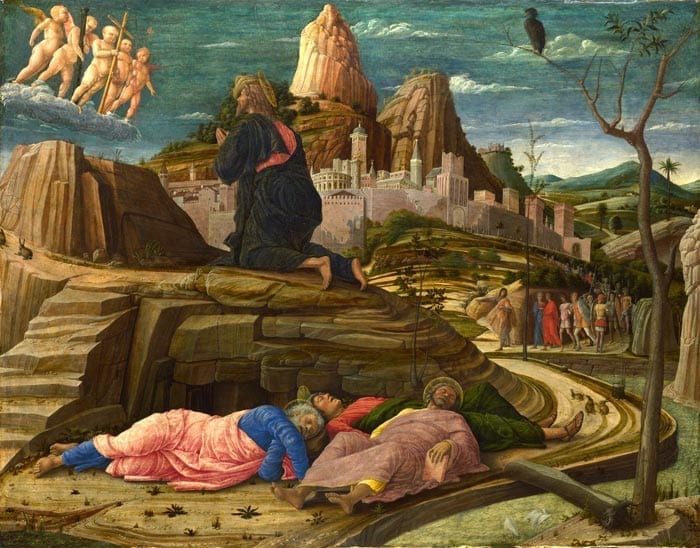
New year, new you!
Over Christmas we become flabby, not only physically, but also mentally. By this I mean we can slip artistically and lose aesthetic rigour as we practice the sin of gluttony and let ham seep from our pores. Sadly, there is no easy solution, but with effort one can alleviate their sin – not by dieting, joining the wagon, or sweating at the gym – no, the only way is to don your smock and recreate a fifteenth century masterpiece.
To help you I suggest copying Mantegna’s Agony in the Garden (currently on show at the National Gallery). I have already done so and now feel like twice the man I was in 2018.
This painting exquisitely depicts Judas’s betrayal and the arrest of Christ before going to the cross. In it we see Christ receive the Instruments of the Passion whilst his disciples snooze unaware of the encroaching army of soldiers snaking out of an imagined Jerusalem. Rendered in tempera it has a brilliant luminosity and crispness which is not replicated in the above photo. With the addition of a sweet trio of rabbits nibbling away at the trodden-grass Mantegna makes even the most hardened atheist hearts tingle with the poetry of the Lord!
Here then follows a guide to redemption.
Ingredients:
A rigid wooden panel
Gesso
Egg tempera
Bole
Gold Leaf
A competitive brother-in-law (called Bellini)
Attention to detail
Talent
Start by choosing your wooden panel. If you wish to be truly authentic visit your local madman-in-the-forest and exchange a tuppence for some poplar wood chopped in the autumn. Make sure it is well seasoned and then cut to size (62.9 x 80cm!). Otherwise compressed fibreboard or seasoned panels of birch framed on pine (which we sell in the shop) are suitable.
Prepare your panel by dusting it with a lint-free cloth and degrease it with a delicate wipe of methylated-spirits. Sit the wood happily on some makeshift feet and allow it to thoroughly dry.
Next prepare a delicious vat of gesso.
Again, if you wish to be truly authentic you must make two stops. First, either go to your local pet shop and buy a rabbit or commit a crime and set an illegal snare in the countryside. After you have done this grace your nearby gypsum mine and buy a kilo or two of the powdered rock. If you can’t get a rabbit you may be truly Renaissance and use clippings of goatskin vellum soaked in water for 24 hours.
To spare yourself the horror of the first stage and the lung damage of the second simply go into the downstairs of our shop and buy yourself a bag of rabbit-skin glue and a bag of gypsum, or a tub of whiting.
To make your gesso mix the two ingredients together in a way better explained in Robert Massey’s Formulas for Painters or Pip Seymour’s The Artist’s Handbook.
Now apply a ‘grip coat’ of mostly glue and a smidge of gypsum powder followed by between 4-10 coats of silky smooth and creamy white gesso. You’ll know if your glue is good if it dries to a clear pale straw colour. If it is bad it will dry dark brown and a cloud of shame will rest above you for the rest of your day.
If you don’t want to do any of this you can again skip the process and exchange some sweet dollar for ‘Gessobord’ pre-gessoed panels! Again, available downstairs!
With your panel now ready and gessoed you may begin to think about paint.
To remake this masterpiece, you must use egg tempera which in this modern-age you can buy in tubes! Or you may dedicate yourself to the handmade process more comprehensively and lengthily described in the previously mentioned books. But essentially, raise yourself a hen, collect its eggs, remove the whites, cut open the egg sac, remove the yolk, wet your pigments, mix the two together, and grind, grind, grind with a muller. Et voila!
With the technicalities over you must begin painting as your handmade egg tempera will go smelly after two days. Make sure to paint delicately and lightly with a fine brush otherwise your painting will crack to bits. Once you have added the finishing touches – the swirling silvery hair, the hundreds of tiny pebbles, the glint of the little rabbits’ eyes – the truly final touch can be added – the golden horse!
Yes, if you look closely, atop Trajan’s column (beautifully rendered in plaster at the V&A) sits a golden horse and rider. Of real gold! Not gold paint, no real gold! So that it shines like the sun! What grace!
To do this apply a little bole and delicately apply with your gilders tip the finest gold leaf in the land (available at little ole Green ‘n’ Stone!). Ta da!
If all goes well and you have followed my instructions closely you should end up with a painting which will make your heart glow with the radiance of God and reinvigorate your mind with the sharpness lost over the Christmas period. To 2019, a year for unparalleled artistic endeavour! Using supplies only from Green and Stone!
By Ned Elliott